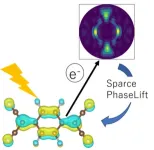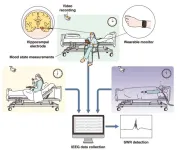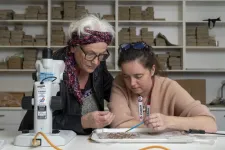(Press-News.org) A new study – published in the Human-Animal Interactions journal – reveals that cows who are cuddled as therapy animals showed a strong preference for interactions with women when compared to men.
In turn, the research, which opens a new era on whether some therapies may be initially stronger based upon gender and not procedure, highlighted that the women also reported greater attachment behaviours towards the steers.
Dr Katherine Compitus, Clinical Assistant Professor at New York University, and Dr Sonya Bierbower, Associate Professor at United States Military Academy West Point, conducted the research using the Human-Animal Interaction Scale (HAIS) as a measurement tool.
HAIS is a 24-item self-report instrument designed to describe and quantify behaviours performed by humans and nonhuman animals during an episode of interaction.
Enrichment benefits of cattle involved in bovine-assisted therapy
The scientists examined the behavioural and cognitive traits of cattle who work as therapy animals and special attention was paid to the welfare and enrichment benefits of cattle involved in bovine-assisted therapy.
Dr Compitus and Dr Bierbower, who conducted their study at the Surrey Hills Sanctuary in New York State, USA, with two steers – named Magnus and Callum – and 11 people aged 13 to 79, say little research has so far addressed the therapeutic benefits of animal-assisted interventions with farm animals.
Of the research sample, six were females and five were males.
Dr Compitus said, “We have discovered in the current study that bovine-assisted therapy may not only be an effective treatment model that benefits human participants but appears to be enriching to the cattle participants as well, as shown by their proximity to and continuous interactions with humans.”
Integrative model used in conjunction with other methods
Animal-assisted therapy (AAT) is an integrative model used in conjunction with other methods such as psychodynamic psychotherapy and cognitive behavioural therapy.
The most common AAT model, the scientists say, is when a companion animal, such as a dog or cat, is integrated into a therapeutic plan.
This model, they add, has been studied with a variety of populations and conditions, from treating substance abuse to autism, often with positive results.
Organizations that certify therapy animals will sometimes certify several species of animals to work as a therapeutic partner, such as llamas, miniature horses, and rabbits.
However, to date there has been little research addressing the therapeutic benefits of animal-assisted interventions with farm animals. Cows have special behavioural traits that allow them to bond with people in a way that is unique to their size and temperament.
Dr Bierbower said, “Two of the gaps in the research we address in this study are the inclusion of cattle in AAT and an examination of the cognitive processes of animals involved in AAT.”
Cattle that enjoy human company will have reduced stress signals
Cattle that are uncomfortable with a human presence, the researchers suggest, will show an increase in stress signals such as vocalizations when involved in therapy work, while cattle that enjoy human company will have reduced stress signals.
Other notable behaviours in cattle during AAT may include lying down and licking or smelling the person. This is indicative of their comfort level with humans since cows are known to engage in social grooming.
With the two cattle in the study, Dr Compitus and Dr Bierbower found that after 45 minutes of contact with the humans, Magnus and Callum often smelled or licked them and accepted food from them.
They also allowed physical human-initiated interactions in the form of hugs, grooming, petting, or kisses.
The animals rarely made unfriendly or aggressive gestures towards them, though they would occasionally decline to interact.
One participant stated that she was worried the bulls would be more aggressive but “fell in love with cows” after the session. All participants reported having an overall positive session with the steers and most stated they would recommend bovine assisted therapy to a friend.
Strong preference or interactions with women compared to men
Dr Compitus said, “The results of this study show that the steers showed a strong preference or interactions with women compared to men, and, in turn, the women reported stronger attachment behaviours towards the steers.
“It is unclear without further testing whether the animals sought out the attention of women in general or if the women were more likely to initiate the actions when compared to the men participants.”
The scientists conclude that they discovered in the study that bovine-assisted therapy may not only be an effective treatment model that benefits human participation but appears to be enriching to the cattle participants, as well, as shown by their proximity to and continuous interactions with humans.
Full paper reference
Compitus, Katherine; Bierbower, Sonya, ‘Cow Cuddling: Cognitive Considerations in Bovine-Assisted Therapy,’ Human-Animal Interactions, 22 May (2024). DOI: 10.1079/hai.2024.0016
The paper can be read open access from 13:00hrs UK time 22 May 2024, here: https://www.cabidigitallibrary.org/doi/10.1079/hai.2024.0016
Media enquiries
For more information and an advance copy of the paper contact:
Dr Katherine Compitus, Clinical Assistant Professor, New York University – email: kog206@nyu.edu
Wayne Coles, Senior PR Manager, CABI – email: w.coles@cabi.org
About Human—Animal Interactions
Human—Animal Interactions is an open access interdisciplinary journal devoted to the dissemination of research in all fields related to interactions between non-human animals and their human counterparts.
About CABI
CABI is an international not-for-profit organization that improves people’s lives by providing information and applying scientific expertise to solve problems in agriculture and the environment.
Through knowledge sharing and science, CABI helps address issues of global concern such as improving global food security and safeguarding the environment. We do this by helping farmers grow more and lose less of what they produce, combating threats to agriculture and the environment from pests and diseases, protecting biodiversity from invasive species, and improving access to agricultural and environmental scientific knowledge. Our 48-member countries guide and influence our core areas of work, which include development and research projects, scientific publishing, and microbial services.
We gratefully acknowledge the core financial support from our member countries (and lead agencies) including the United Kingdom (Foreign, Commonwealth and Development Office), China (Chinese Ministry of Agriculture and Rural Affairs), Australia (Australian Centre for International Agricultural Research), Canada (Agriculture and Agri-Food Canada), Netherlands (Directorate-General for International Cooperation, and Switzerland (Swiss Agency for Development and Cooperation). Other sources of funding include programme/project funding from development agencies, the fees paid by our member countries and profits from our publishing activities which enable CABI to support rural development and scientific research around the world.
END
New study: Cuddled cows who work as therapy animals showed a strong preference for women compared to men
A new study – published in the Human-Animal Interactions journal – reveals that cows who are cuddled as therapy animals showed a strong preference for interactions with women when compared to men.
2024-05-22
ELSE PRESS RELEASES FROM THIS DATE:
Flexible film senses nearby movements — featured in blink-tracking glasses
2024-05-22
I’m not touching you! When another person’s finger hovers over your skin, you may get the sense that they’re touching you, feeling not necessarily contact, but their proximity. Similarly, researchers reporting in ACS Applied Materials & Interfaces have designed a soft, flexible film that senses the presence of nearby objects without physically touching them. The study features the new sensor technology to detect eyelash proximity in blink-tracking glasses.
Noncontact sensors can identify or measure an object without directly touching it. Examples of these devices include ...
A simpler method for precise molecular orbital visualization
2024-05-22
Discoveries and progress in materials science often lay the foundation for technological breakthroughs that reshape many industrial and commercial fields, including medicine, consumer electronics, and energy generation, to name a few. Yet, the development of experimental techniques crucially underpins the exploration of new materials, paving the way for groundbreaking discoveries. These techniques allow scientists to delve into a material’s chemical and physical properties, unlocking insights essential for realizing their potential applications.
In a recent study ...
New evidence suggests link between teen cannabis use and psychotic disorders may be stronger than previously thought
2024-05-22
Toronto, ON, May 22, 2024 – A new study published in the journal Psychological Medicine estimates that teens using cannabis are at 11 times higher risk of developing a psychotic disorder compared to teens not using cannabis.
This finding suggests that the association between cannabis and psychotic disorders may be stronger than indicated by previous research, which has relied largely on older data when cannabis was less potent than today. For context, the average THC potency of cannabis in Canada has increased from roughly 1% in 1980 to 20% in 2018.
Researchers from the University of Toronto, the Centre for Addiction and Mental ...
Risk of under-treatment and over-treatment in a group of Australian men diagnosed with prostate cancer
2024-05-22
Background and objectives
Patients with newly diagnosed prostate cancer (PCA) face the critical decision of whether to undergo treatment with curative intent (TCI, surgery or radiation) or conservative treatment on the background of a cancer where the potential for over-treatment and under-treatment is real. This study aimed to investigate the influence of cancer- and patient-related factors on the initial treatment decision for men with a new diagnosis of PCA and to evaluate treatment decisions against relevant guidelines.
Methods
This study undertook a retrospective ...
Atypia of undetermined significance in thyroid fine needle aspiration cytology revisited
2024-05-22
Background and objectives
Fine needle aspiration cytology (FNAC) is a cost-efficient technique for the management of thyroid nodules. Changes in the World Health Organization classification of thyroid tumors can influence reliability of cytology. The 2023 Bethesda System for Reporting Thyroid Cytopathology has adapted cytological nomenclature to these changes. The aim of this paper was to review the management of atypia of undetermined significance (AUS) in our institution.
https://www.xiahepublishing.com/2771-165X/JCTP-2023-00062
Methods
Retrospective review of thyroid FNAC diagnosed with AUS in a single hospital between 2014 and 2022. We analyzed the management ...
Smoke covered 70% of California during biggest wildfire years
2024-05-22
As much as 70% of California was covered by wildfire smoke during parts of 2020 and 2021, according to a study from the University of California, Davis. The study, published today in the journal Communications: Earth & Environment, combined lake-based sensors with satellite imagery to find that maximum smoke cover has increased by about 116,000 square miles since 2006.
The study measured lake responses to wildfire smoke in 2018, 2020 and 2021 — the three largest fire seasons on record in California. It found the lakes were exposed ...
Extreme temperatures may increase risk of stroke mortality, especially in low-income countries
2024-05-22
Embargoed for release: Wednesday, May 22, 2024, 5:00 AM ET
Key points:
In a large, multinational investigation of the link between extreme temperatures and stroke mortality, researchers found that of every 1,000 ischemic or hemorrhagic stroke deaths, about 11 were attributable to extreme cold and hot days.
The study also found that low-income countries bore a higher burden of heat-related hemorrhagic stroke mortality than high-income countries.
The researchers foresee an increase in fatal strokes, as well as a widening disparity ...
From ripples to daydreams: the brain activity behind mind wandering
2024-05-22
Osaka, Japan – Part of what makes us human is our ability to think about people, places, or events that aren’t currently present—but we still don’t know exactly how our brains do this. Now, researchers from Osaka University have identified a specific kind of brain activity linked with these kinds of thoughts, such as when we daydream or let our minds wander.
When we think about things that aren’t actually happening, like when we daydream, the brain is essentially making up information rather than receiving and ...
Ancient viral DNA in the human genome linked to major psychiatric disorders.
2024-05-22
New research led by King’s College London has found that thousands of DNA sequences originating from ancient viral infections are expressed in the brain, with some contributing to susceptibility for psychiatric disorders such as schizophrenia, bipolar disorder, and depression.
Published in Nature Communications, the study was part-funded by the National Institute for Health and Care Research (NIHR) Maudsley Biomedical Research Centre and the US National Institutes of Health (NIH).
About eight percent of our genome is comprised of sequences called Human Endogenous Retroviruses (HERVs), which are products of ancient viral infections ...
Excavation reveals ‘major’ ancient migration to Timor Island
2024-05-22
The discovery of thousands of stone artefacts and animal bones in a deep cave in Timor Island has led archaeologists to reassess the route that early humans took to reach Australia.
Researchers from The Australian National University (ANU), Flinders University, University College London (UCL) and the ARC Centre of Excellence for Australian Biodiversity and Heritage dated and analysed the artefacts and sediment at the Laili rock shelter in central-north Timor-Leste, north of Australia, to pinpoint the arrival ...
LAST 30 PRESS RELEASES:
Why nail-biting, procrastination and other self-sabotaging behaviors are rooted in survival instincts
Regional variations in mechanical properties of porcine leptomeninges
Artificial empathy in therapy and healthcare: advancements in interpersonal interaction technologies
Why some brains switch gears more efficiently than others
UVA’s Jundong Li wins ICDM’S 2025 Tao Li Award for data mining, machine learning
UVA’s low-power, high-performance computer power player Mircea Stan earns National Academy of Inventors fellowship
Not playing by the rules: USU researcher explores filamentous algae dynamics in rivers
Do our body clocks influence our risk of dementia?
Anthropologists offer new evidence of bipedalism in long-debated fossil discovery
Safer receipt paper from wood
Dosage-sensitive genes suggest no whole-genome duplications in ancestral angiosperm
First ancient human herpesvirus genomes document their deep history with humans
Why Some Bacteria Survive Antibiotics and How to Stop Them - New study reveals that bacteria can survive antibiotic treatment through two fundamentally different “shutdown modes”
UCLA study links scar healing to dangerous placenta condition
CHANGE-seq-BE finds off-target changes in the genome from base editors
The Journal of Nuclear Medicine Ahead-of-Print Tip Sheet: January 2, 2026
Delayed or absent first dose of measles, mumps, and rubella vaccination
Trends in US preterm birth rates by household income and race and ethnicity
Study identifies potential biomarker linked to progression and brain inflammation in multiple sclerosis
Many mothers in Norway do not show up for postnatal check-ups
Researchers want to find out why quick clay is so unstable
Superradiant spins show teamwork at the quantum scale
Cleveland Clinic Research links tumor bacteria to immunotherapy resistance in head and neck cancer
First Editorial of 2026: Resisting AI slop
Joint ground- and space-based observations reveal Saturn-mass rogue planet
Inheritable genetic variant offers protection against blood cancer risk and progression
Pigs settled Pacific islands alongside early human voyagers
A Coral reef’s daily pulse reshapes microbes in surrounding waters
EAST Tokamak experiments exceed plasma density limit, offering new approach to fusion ignition
Groundbreaking discovery reveals Africa’s oldest cremation pyre and complex ritual practices
[Press-News.org] New study: Cuddled cows who work as therapy animals showed a strong preference for women compared to menA new study – published in the Human-Animal Interactions journal – reveals that cows who are cuddled as therapy animals showed a strong preference for interactions with women when compared to men.





